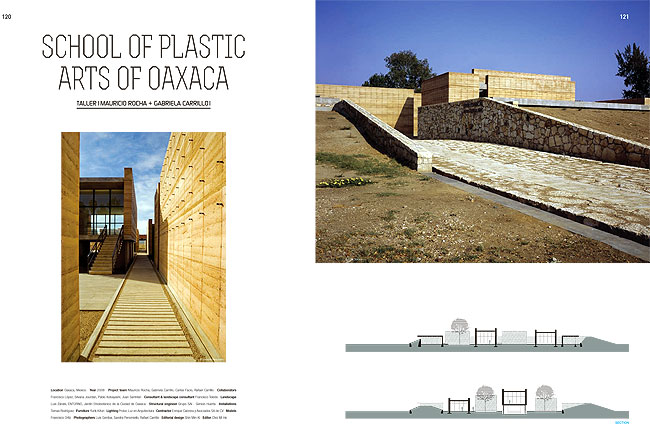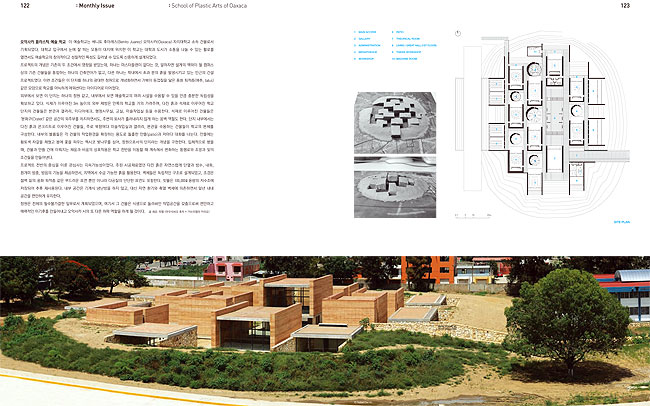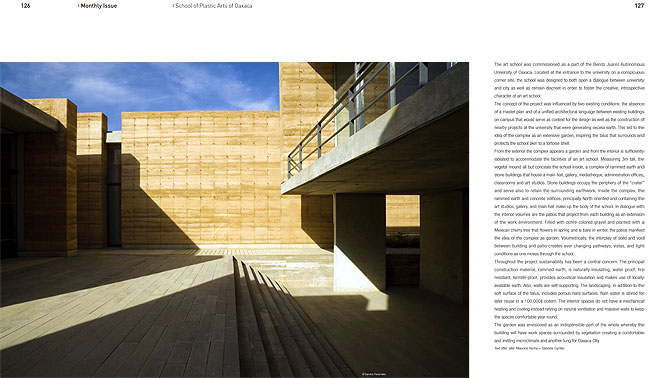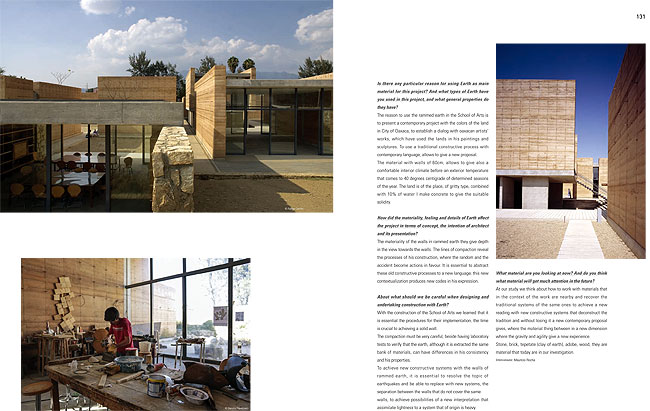School of Plastic Arts of Oaxaca
Taller | Mauricio Rocha + Gabriela Carrillo |




오악사카 플라스틱 예술 학교 이 예술학교는 베니토 후아레스(Benito Juarez) 오악사카(Oaxaca) 자치대학교 소속 건물로서 기획되었다. 대학교 입구에서 눈에 잘 띄는 모퉁이 대지에 위치한 이 학교는 대학과 도시가 소통을 나눌 수 있는 활로를 열면서도 예술학교의 창의적이고 성찰적인 특성도 길러낼 수 있도록 신중하게 설계되었다.
프로젝트의 개념은 기존의 두 조건에서 영향을 받았는데, 하나는 마스터플랜이 없다는 것, 말하자면 설계의 맥락이 될 캠퍼스 상의 기존 건물들을 통합하는 하나의 건축언어가 없고, 다른 하나는 학내에서 초과 분의 흙을 발생시키고 있는 인근의 건설 프로젝트였다. 이런 조건들은 이 단지를 하나의 광대한 정원으로 개념화하면서 거북이 등껍질을 닮은 풍화 퇴적층(애추, talus) 같은 모양으로 학교를 아늑하게 에워싼다는 아이디어로 이어졌다.
외부에서 보면 이 단지는 하나의 정원 같고, 내부에서 보면 예술학교의 여러 시설을 수용할 수 있을 만큼 충분한 독립성을 확보하고 있다. 식재가 이루어진 3m 높이의 외부 제방은 안쪽의 학교를 거의 가려주며, 다진 흙과 석재로 이루어진 학교 단지의 건물들은 본관과 갤러리, 미디어테크, 행정사무실, 교실, 미술작업실 등을 수용한다. 석재로 이루어진 건물들은 ‘분화구(Crater)’같은 공간의 외주부를 차지하면서도, 주변의 토사가 흘러내리지 않게 하는 옹벽 역할도 한다. 단지 내부에서는 다진 흙과 콘크리트로 이루어진 건물들, 주로 북향에다 미술작업실과 갤러리, 본관을 수용하는 건물들이 학교의 본체를 구성한다. 내부의 볼륨들은 각 건물의 작업환경을 확장하는 용도로 돌출한 안뜰(patio)과 저마다 대화를 나눈다. 안뜰에는 황토색 자갈을 채웠고 봄에 꽃을 피우는 멕시코 벚나무를 심어, 정원으로서의 단지라는 개념을 구현한다. 입체적으로 봤을 때, 건물과 안뜰 간에 이뤄지는 채움과 비움의 상호작용은 학교 전반을 이동할 때 계속해서 변화하는 통행로와 조망과 빛의 조건들을 만들어낸다.
프로젝트 전반의 중심을 이룬 관심사는 지속가능성이었다. 주된 시공재료였던 다진 흙은 자연스럽게 단열과 방수, 내화, 흰개미 방충, 방음의 기능을 제공하면서, 지역에서 수급 가능한 흙을 활용한다. 벽체들은 독립적인 구조로 설계되었고, 조경은 절벽 밑의 풍화 퇴적층 같은 부드러운 표면 뿐만 아니라 다공질의 단단한 표면도 포함한다. 빗물은 100,000 용량의 저수조에 저장되어 추후 재사용된다. 내부 공간은 기계식 냉난방을 하지 않고, 대신 자연 환기와 축열 벽체에 의존하면서 일년 내내 공간을 편안하게 유지한다.
정원은 전체의 필수불가결한 일부로서 계획되었으며, 여기서 그 건물은 식생으로 둘러싸인 작업공간을 갖춤으로써 편안하고 매력적인 미기후를 만들어내고 오악사카 시의 또 다른 허파 역할을 하게 될 것이다. 글 제공: 따옐 |마우리씨오 호차 + 가브리엘라 카리요|
이 프로젝트에서 흙을 주재료로 사용한 이유는 무엇이며, 사용된 흙의 종류와 그 특성에 대해 설명해달라.
예술학교에 다진 흙을 사용한 이유는 오악사카 시의 땅 색깔로 현대적인 프로젝트를 제시하고, 그림과 조각에 땅을 활용해온 오악사카 예술가들의 작업과 대화를 나누기 위해서였다. 전통적인 시공과정에 현대 언어를 활용함으로써, 새로운 제안을 할 수 있게 된다. 60cm 두께의 벽 재료는 매년 일정 계절에 외부 온도가 40°C에 달하기 전에 편안한 실내 기후를 제공한다. 땅은 사질 유형의 장소에 위치하지만, 물을 10% 결합하여 다지면 적절한 경도를 낸다.
작품의 개념, 건축가의 의도, 주제 표현 등을 위해 흙의 물성, 느낌 또는 디테일이 작품에서 어떤 역할을 하는가?
흙다짐 벽체의 물성은 벽체를 바라볼 때 깊이를 부여한다. 흙을 다진 선들은 시공 과정을 드러내고, 여기서는 무작위적이고 우연적인 것이 선호된다. 이 오래된 시공과정을 새로운 언어로 추상화하는 게 필수적이다. 이렇게 새롭게 맥락화하는 것은 표현에 있어 새로운 규칙을 만들어 낸다.
흙을 다루는 건축물의 설계, 시공 과정의 주안점은 무엇이라고 생각하는가?
예술학교를 시공하면서 우리는 프로젝트 시행에 필수적인 절차를 배웠는데, 튼튼한 벽체를 만드는 데에는 시간이 매우 중요하단 점이었다. 다짐은 아주 세심하게 이뤄줘야 할 뿐만 아니라, 흙이 똑같은 토양에서 나온 것이라 할지라도 고르기와 속성에 있어서는 차이가 있을 수 있음을 증명하는 실험도 거쳐야 한다.
흙다짐 벽체로 새로운 구조체계를 얻으려면 지진부터 해결하는 것이 필수적이며, 그래야만 벽체를 완전히 채우지않고 사이를 분리하여, 본래의 무거운 벽체를 가볍게 할 수 있는 시스템으로 바뀔 수 있다.
현재 주목하고 있는 재료는 어떤 것이며, 앞으로 주목 받을 재료는 무엇이라고 보는가?
우리의 연구에서는 어떻게 작업의 맥락에 맞는 인근 재료로 작업하는 법과 똑같은 전통적 시스템을 복원하여 전통을 해체하는 구축체계의 새로운 해석 방법에 대해 생각하고 있다. 새로운 차원의 무거움과 가벼움 사이에서 재료가 새로운 경험을 제공하는, 전통을 잃지 않은 새로운 현대적 제안을 고민 중이다. 요즘에는 석재와 벽돌, 다진 흙(tepetate), 어도비(adobe) 벽돌, 목재와 같은 재료를 연구하고 있다.
인터뷰이: 마우리씨오 호차
The art school was commissioned as a part of the Benito Juarez Autonomous University of Oaxaca. Located at the entrance to the university on a conspicuous corner site, the school was designed to both open a dialogue between university and city as well as remain discreet in order to foster the creative, introspective character of an art school. The concept of the project was influenced by two existing conditions: the absence of a master plan and of a unified architectural language between existing buildings on campus that would serve as context for the design as well as the construction of nearby projects at the university that were generating excess earth.
This led to the idea of the complex as an extensive garden, inspiring the talus that surrounds and protects the school akin to a tortoise shell. From the exterior the complex appears a garden and from the interior is sufficiently isolated to accommodate the facilities of an art school. Measuring 3m tall, the vegetal mound all but conceals the school inside, a complex of rammed earth and stone buildings that house a main hall, gallery, mediatheque, administration offices, classrooms and art studios. Stone buildings occupy the periphery of the “crater” and serve also to retain the surrounding earthwork.
Inside the complex, the rammed earth and concrete edifices, principally North-oriented and containing the art studios, gallery, and main hall make up the body of the school. In dialogue with the interior volumes are the patios that project from each building as an extension of the work environment. Filled with ochre-colored gravel and planted with a Mexican cherry tree that flowers in spring and is bare in winter, the patios manifest the idea of the complex as garden. Volumetrically, the interplay of solid and void between building and patio creates ever changing pathways, vistas, and light conditions as one moves through the school.
Throughout the project sustainability has been a central concern. The principal construction material, rammed earth, is naturally insulating, water proof, fire resistant, termite-proof, provides acoustical insulation and makes use of locally available earth. Also, walls are self-supporting. The landscaping, in addition to the soft surface of the talus, includes porous hard surfaces. Rain water is stored for later reuse in a 100,000 cistern. The interior spaces do not have a mechanical heating and cooling instead relying on natural ventilation and massive walls to keep the spaces comfortable year round.
The garden was envisioned as an indispensible part of the whole whereby the building will have work spaces surrounded by vegetation creating a comfortable and inviting microclimate and another lung for Oaxaca City.
Text offer: aller |Mauricio Rocha + Gabriela Carrillo|
Is there any particular reason for using Earth as main material for this project? And what types of Earth have you used in this project, and what general properties do they have?
The reason to use the rammed earth in the School of Arts is to present a contemporary project with the colors of the land in City of Oaxaca, to establish a dialog with oaxacan artists’ works, which have used the lands in his paintings and sculptures.
To use a traditional constructive process with contemporary language, allows to give a new proposal. The material with walls of 60cm, allows to give also a comfortable interior climate before an exterior temperature that comes to 40 degrees centigrade of determined seasons of the year. The land is of the place, of gritty type, combined with 10% of water I make concrete to give the suitable solidity.
How did the materiality, feeling and details of Earth affect the project in terms of concept, the intention of architect and its presentation?
The materiality of the walls in rammed earth they give depth in the view towards the walls. The lines of compaction reveal the processes of his construction, where the random and the accident become actions in favour. It is essential to abstract these old constructive processes to a new language; this new contextualization produces new codes in his expression.
About what should we be careful when designing and undertaking construction with Earth?
With the construction of the School of Arts we learned that it is essential the procedures for their implementation, the time is crucial to achieving a solid wall. The compaction must be very careful, beside having laboratory tests to verify that the earth, although it is extracted the same bank of materials, can have differences in his consistency and his properties.
To achieve new constructive systems with the walls of rammed earth, it is essential to resolve the topic of earthquakes and be able to replace with new systems, the separation between the walls that do not cover the same walls, to achieve possibilities of a new interpretation that assimilate lightness to a system that of origin is heavy.
What material are you looking at now? And do you think what material will get much attention in the future?
At our study we think about how to work with materials that in the context of the work are nearby and recover the traditional systems of the same ones to achieve a new reading with new constructive systems that deconstruct the tradition and without losing it a new contemporary proposal gives, where the material thing between in a new dimension where the gravity and agility give a new experience. Stone, brick, tepetate (clay of earth), adobe, wood, they are material that today are in our investigation.
Interviewee: Mauricio Rocha
건축문화 2016년 11월호 [Monthly Issue]페이지 © 에이엔씨출판(주)